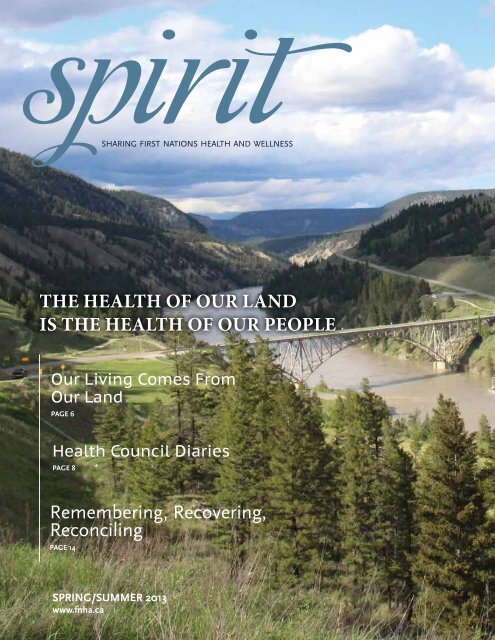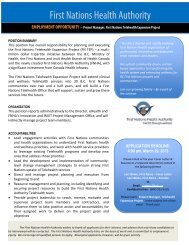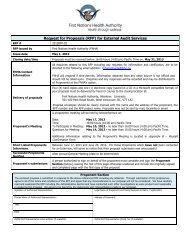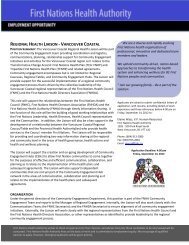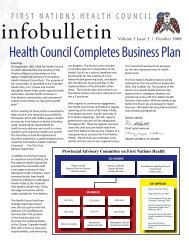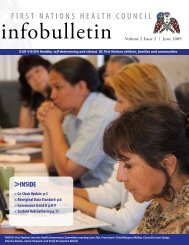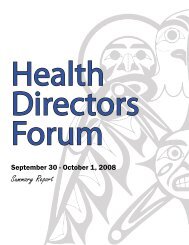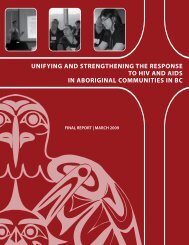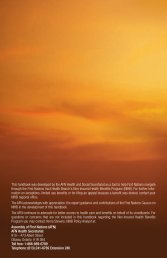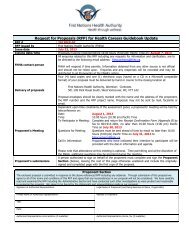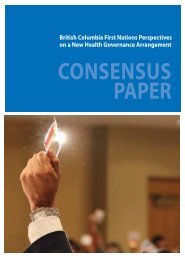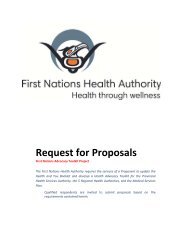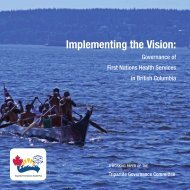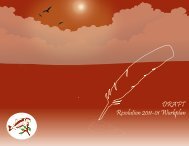Spirit Magazine Spring/Summer issue PDF - First Nations Health ...
Spirit Magazine Spring/Summer issue PDF - First Nations Health ...
Spirit Magazine Spring/Summer issue PDF - First Nations Health ...
You also want an ePaper? Increase the reach of your titles
YUMPU automatically turns print PDFs into web optimized ePapers that Google loves.
sharing first nations health and wellnessthe health of our landis the health of our peopleOur Living Comes FromOur LandPAGE 6<strong>Health</strong> Council DiariesPAGE 8Remembering, Recovering,ReconcilingPAGE 14SPRING/SUMMER 2013www.fnha.ca
Over $40,000in Community Wellness Prizes Availablein two categories: Most Inches Lost & Most Weight LostRegister today and inspire your community!Contest closes October 15th, 2013 | Sign up at www.fnhc.ca
EditorialThe <strong>Health</strong> of Our Land is the <strong>Health</strong> of Our PeopleIn our first <strong>issue</strong> of <strong>Spirit</strong> ‘The Harvest’(Fall 2012) we touched on how a healthyenvironment is essential for healthy communities.In this <strong>issue</strong> we expand on thisconcept and ask BC <strong>First</strong> <strong>Nations</strong>: ‘What isthe connection between land (territory) andhealth?’ For many the connection to landis a connection to spirit, culture, community,our Nation, and a special place withinourselves.In Ćəŕtups (Carmella Alexis) story ‘OurLiving Comes from the Land’ (Pg 6) shewrites, “As a people our identity is intertwinedwith the land. To care for the landthrough ceremonies and traditional practicesis to care for ourselves and our spirits.”We rely on the land for our livelihood andsurvival – it offers us all we need and willcontinue to do so if it is kept healthy. Thereis much development taking place in whatis now known as BC. Projects in all cornersof the province like mining, forestry, oiland gas, and of course numerous pipelineshave many angles of debate found in allcommunities.As <strong>First</strong> <strong>Nations</strong> <strong>Health</strong> Council Interiorrepresentative Ko’waintco Michel says in‘Preparing for the Fast’ (Pg 8), “It’s realizingthat if the land is not well then we are notwell.” While we live in an abundant land, insome circles there is a thought that ‘there’snot enough to go around’, that we are livingin ‘tough economic times’, or that somehowour children are born with a debt to be paid.None of this existed pre-contact – theseconcepts came from foreign lands with foreignrules, and outdated ways of operating.Self-determination, personal empowerment,or ‘self-mastery’ as it is called isconsidered a social determinant of health.In a <strong>First</strong> <strong>Nations</strong> context self-determinationis a multi-level concept, taking intoaccount personal, familial, and Nationwiderights and obligations. The ability todetermine one’s own destiny and life pathhas a direct connection to how well we are.Through traditional, customary and naturallaw, <strong>First</strong> <strong>Nations</strong> have been stewards of theland for generations. The ability to determineones relationship with the land, inaccordance with these laws, maintains abalance between rights and responsibilities.Economic development is also considered asocial determinant of health, but it can turninto a social detriment quickly. Meaningfulparticipation in economic development isessential for communities whose territorythese projects take place in. But it can’t justbe about money, it must be about raisingthe standard of living and social determinantsof health for the entire community tooffer a healthier future for this and the nextseven generations. Similarly we must knowthe difference between what we need andthings we want. If we look to our land andterritories – we will often find everythingwe need – mentally, emotionally, spirituallyand physically.In ‘Protecting the Sacred’ (Pg 18) ChiefMaureen Thomas reminds us that <strong>First</strong><strong>Nations</strong> role as stewards is often tied togreater public interest, “We believe that ahealthy Burrard Inlet is directly linked to thewell-being of Vancouver and the millions ofpeople that live around its shores.”As <strong>First</strong> <strong>Nations</strong> <strong>Health</strong> Council representativeGwen Phillips says (Pg 9), “Over the longterm we will see more benefit with healthyland than we would with short term financialgain. Our lands, water and air can providemore than enough for us as it has for manygenerations and will for many more.”What does a healthy environment mean toyou and your Nation? Connect with othersin your community and get the conversationgoing about the wellness of our lands andour people. Engage with your local Environmental<strong>Health</strong> Officer, start the discussion,and send us your thoughts to <strong>Spirit</strong>magazine@fnha.ca.We hope you enjoy this <strong>issue</strong>of <strong>Spirit</strong> and it can remind us all of ourconnection to the land and its place in ourhealth and wellness. - <strong>Spirit</strong>There are many successstories of <strong>First</strong> <strong>Nations</strong>communities balancingeconomic and resourcedevelopment in theirterritories, and offeringemployment andfinancial benefits locally.Economic securityguided by carefullymanaged resourcesand wealth, sharedthroughout the entirecommunity, can allowfor other opportunitiesin elevating healththrough wellness forself-determining andvibrant BC <strong>First</strong> <strong>Nations</strong>children, families andcommunities.<strong>Spirit</strong> <strong>Magazine</strong> • www.fnha.ca • 1
FNHC Have Your Diaries Say…What is the connection betweenland (territory) and health?“<strong>First</strong> Nation people have a symbiotic relationship with the land. Some refer to the relationship as stewards,but it is a much deeper connection. This explains why either as we age or left the area to pursue work or educationthat we have an unexplained longing to see and explore our traditional territories. When you returnhome the land sends you messages from others it supports like the rocks, trees, water and animals. The landhas nurtured our people through this symbiotic relationship and it is our responsibility to pass on this knowledgeto the next generations.”Paul Mercer, Tsuut’im Ty’aayt, Wilps Duuk from the Nisga’a Village of Gitlaxt’aamixs“Put simply, the reserve system removed us from the land physically and residential schools removed usspiritually. Only through ceremony, language and land-based practices and defense; rebuilding a fracturedrelationship, addressing the root causes, will we as peoples find true wellness again. The health of the landand people, indeed the fate of the land and people, are one and the same.”Ryan Day, Secwepemc Nation“With connection to our lands, culture and history our People can survive anything. That connection providesthe strongest foundation to who we are and where we come from - a foundation that helps us survive in themodern world. Without the connection to traditional lands/territory it is difficult to pass on traditional knowledgeand culture to future generations because the hands on experience is missing. Our land is connected tooverall health and wellbeing - our traditional medicines, foods and our teachings.”Gla tle gla tle tlo se la o gwa (Sally Williams), Gwawaenuk Tribe“The land is the physical place we live our lives in. It is a physical representation of how we see ourselvesand what we value most. If we nourish it, it will nourish us. If we degrade it, it will reinforce that same valuewe place on ourselves. It is a reflection, a mirror of our own level of health and what we choose everyday asour priorities.”Coco Miller, Gitxsan/Tsimshian and a member of the Kitselas <strong>First</strong> Nation“Our land is a part of who we are, it is a part of our spirit and where we get our foods to nourish us, our history,our culture and identity, without it, we cannot exist.”Annita McPhee, Tahltan Nation
TECH Wellness | John PantherboneZombies Run!Can’t get motivated to exercise? Are most exercise apps boring or un-engaging toyou? Why not add a little gaming to your workouts? And escape some zombies whileyou’re at it.<strong>Spirit</strong> <strong>Magazine</strong>A publication of the<strong>First</strong> <strong>Nations</strong> <strong>Health</strong> Authority501-100 Park Royal South V7T 1A2Coast Salish Territory (West Vancouver, BC)Phone: 604-913-2080Fax: 604-913-2081<strong>Spirit</strong>magazine@fnha.cawww.fnha.caThe content, opinions and views expressedin <strong>Spirit</strong> <strong>Magazine</strong> are thoseof the authors and do not necessarilyrepresent the views held by the FNHA, itsemployees or member organizations.We WANT to publishYour content!Please send story ideas, articles, and photographsto: <strong>Spirit</strong>magazine@fnha.caContributors:Ko’waintco Michel, Gwen Philips, CarmellaAlexis, Jan Ice, Dr. Georgia Kyba, Dr. RosalinMiles, Vanessa Mitchell, Sarah Thomas,Dr. Evan Adams, John Pantherbone, PhilipHogan, Trevor KehoeMost exercise apps include some elementsof gamification in them, but oftenthey tend to have basic simplistic ‘badge’reward systems. Some often are verygeneric (Yay - the 5k badge!). They can bemotivating enough for some, especiallywith the social aspects of badges. Forinstance including your achievementson your Twitter or Facebook page, butothers might not care or would lose trackof them. Throw in a little role playingelements to your workout and you haveyourself a whole new level of exercisemotivation.Zombies, Run! Is an Android/iOS runninggame that does just that. Combiningexercise achievements with role playingelements into a post-apocalyptic zombiescapethat plays out through your earbuds.The stories/campaigns use voice actingand audio notifications to track yourprogress throughout a story. Start a newcampaign and you’ll begin your workoutwith a voice telling you bits and piecesof a story/mission. Along the way you’llpick up items like health, food, and toolsto help you in the story and motivate youto run more. Fall behind or lose the campaignand you’ll be notified with a friendly‘Zombie has caught you’. I had some minorgripes with the app. For instance eachmission has to be downloaded and if youhave a limited or slow phone connectionlike me it can take a while. Also, theretends to be a few lulls with long periodsof silence that confused me “Did the appjust quit? Is there audio coming up?” Moreminor audio notifications like “keep running”or something would keep up themotivation and prevent confusion. Otherthan that my experience with the app hasbeen great. If you can’t get motivated withmost exercise apps and are into gaming orjust escaping zombies then check out thisapp. It’s worth the price. 4/5.FNHA on InstagramCongratulations to PUGDADDY07 winnerof the FNHA Instagram contest. Here’s hiswinning shot.http://instagram.com/p/ZdniAtNZMO/#Correction:In the Winter Issue of <strong>Spirit</strong> Judith Gohn was incorrectly identified as the <strong>Health</strong> Directorfor Cowichan Lake - she is the <strong>Health</strong> Director for Ts’ewulhtun <strong>Health</strong> of Cowichan Tribeswith a population over 4600. We apologize for this inaccuracy.
Doc’ Talkwith Dr. Evan Adamsdeputy provincial health officerIf my wild meat or fish looks contaminated whatshould I do? When does this food become unsafe toeat? What if wild game is our main source of food?I’m assuming you mean 2 different kinds of contamination: an environmentalcontaminant, like a chemical or radiation, vs. your foodhas ‘gone off’ – a microbiological contamination. Chemical or radiationcontamination may not look or taste contaminated but cancause harm over prolonged exposure. Pesticides, heavy metals, andpost-Fukushima fall-out are examples. In these cases of known, localcontamination, very often, there are clear guidelines around what aresafe levels to eat. For this and/or if you suspect chemical contamination,you can ask the Environmental <strong>Health</strong> Officer in your regionalhealth authority. If you are concerned about microbiological contamination(e.g. botulism from fermented or dried seafood, or fromimproperly-sealed canned goods) and some naturally-occurringtoxins (e.g. ‘red tide’ shellfish toxin), do not ingest, and notify yourEnvironmental <strong>Health</strong> Officer for investigation. All this being said,the nutritional health of Aboriginal communities is most positivelyaffected when they have broad access to traditional foods such asfish, moose, and berries. Almost all country foods are safe, and abetter alternative than the calorie-denseness low quality of manymodern, obesogenic foods.Even if I don’t feel sick – how often should I see adoctor for a check-up?What is fetal alcohol syndrome? How much alcoholduring what stages of pregnancy results in this?Fetal Alcohol Syndrome (FAS) is a specific pattern of abnormalitiesseen in some children of women who drank heavily during pregnancy,and it is the only cause of mental retardation that is trulypreventable. FAS is now recognized by many as the leading knowncause of mental retardation in the United States. It is estimated thatone in every 750 live births is a child with FAS.Fetal Alcohol Spectrum Disorder (FASD) describes a range of effectsthat may include physical, mental, behavioural and learning disabilitieswith lifelong implications.Since FAS was first described in 1973, it has become apparent thatit is complex; affected people exhibit a wide range of expression,from severe growth restriction, intellectual disability, birth defectsand characteristic dysmorphic facial features to normal growth,facial features and intellectual abilities, but with lifelong deficitsin several domains of brain function.Since we don’t know how much a mother needs to drink in orderto affect her child, the medical recommendation is that pregnantwomen at all stages of pregnancy abstain from drinking alcohol. Ifyou’re pregnant, and you’re concerned about drinking alcohol, yourdoctor can help.Preventive medicine is a cornerstone to the practice of family medicine,but is often difficult to implement because of a lack of timeand logistical difficulties. In 2010-11, an easy-to-use PreventiveCare Checklist Form for family physicians to use during adult completehealth check-ups was built. Check-ups vary by gender andage and health status. More importantly, you can discuss the planfor your particular check-up schedule with your family doctor. Visit:www.cfpc.ca – Resources; Preventative Care Checklist Forms.4 • <strong>Spirit</strong> <strong>Magazine</strong> • www.fnha.ca
My Experience with <strong>First</strong> <strong>Nations</strong> Cultureand How it made me WholePhilip HoganIdon’t recall the exact place or time butsomething I heard at the University of BritishColumbia (UBC) has always stuck withme. Sto:Lo Educator Jo-ann Archibald stated“There is no dignity in an identity that ignoresyour history”. This really resonated with meat the time and still does. The Land is a cornerstoneof <strong>First</strong> <strong>Nations</strong> culture and identity.I know this on a deeply personal level andhave spent many years thinking about it.I am a member of the Heiltsuk Nation but didnot always know it. I was adopted at ten daysof age in 1967. Growing up my parents toldme what they knew about my background –information provided as part of the adoptionprocess. I knew I was an “Indian” of mixedancestry and was given a few non-identifyingdetails. I was fortunate to be raised by goodpeople, I have met many <strong>First</strong> <strong>Nations</strong> peoplethat were adopted or fostered who weren’t.Even so, I always felt confused and vaguelyout of place. While my home life was goodthe same can’t be said of my life outside ofhome.I experienced frequent violence from peersand older youth. One early memory I havefrom Kindergarten, I was forced to fightanother child on top of a shed roof at thelocal school by local teenagers. Violencecontinued throughout elementary schooland into junior high school, waning somewhatafter I went to senior high school. Beingadopted gets inside your head, especially ata young age and when your circumstancesaren’t good. I remember after one fight inelementary school sitting on one of the biggreen mailboxes on the end of my road wishingI was anywhere else.Ever since I can remember I have felt likesomething was missing – like there was a‘big hole’ in me. At times I felt like I had noplace in the world and left as soon as I finishedhigh school. I went to Vancouver andbegan my studies at UBC where I met somevery compassionate <strong>First</strong> <strong>Nations</strong> peoplewho were open to providing me answersto my questions and helped me learn aboutthe history and cultures on the coast. Over aperiod of several years I made connectionsand learned about <strong>First</strong> <strong>Nations</strong> history andculture. I got more accurate and meaningfulinformation from these students than I didfrom any of my coursework.After four years of battling the federal government,and with a quasi-legal processlined up, Indian and Northern Affairs Canadagranted me “Indian Status” and as important,confirmed which Nation I belong to. I learnedat age 21 that I am Heiltsuk, from Bella Bella,but still had never been there and only knewa few Heiltsuk students at UBC.Some very kind Heiltsuk people took meunder their wing and brought me to somecommunity events in Vancouver (local SportsDay, a Dance and several meetings) where Ifirst heard my language spoken and beganto get a sense of the people. Several of thesepeople became very important to me laterin my life. I met my brother David Gladstone,who was also at UBC. It was really quite anawkward situation at first for both of us.David ended up inviting me to visit BellaBella when I graduated in 1992. I arrivedin Bella Bella at night by Ferry from PrinceRupert intending to stay a week and woundup staying for ten years.Going to Bella Bella for the first time wasperhaps the most powerful and overwhelmingexperience I have ever had. From theoutset people were exceptionally kind andwelcoming. One of the most powerful experiencesI had was when my brother Davidtook me to a feast at the community halland introduced me to some 400 people inattendance. We stood up in front of the communityand he talked about who I am andthat I am returning home. He then took meto introduce me to the Hemas (HereditaryChiefs) who were in attendance. To this dayI can only remember the event hazily as Iwas completely overwhelmed by the warmthof the Chiefs and of the community present.In the ten years I spent living in Bella Bella Ibecame very involved in the community, theculture and got to learn about our connectionto our Territory. I was very fortunate withmany of the Elder Ladies taking an interestin me, teaching me and on three occasionsadopting me in the Potlatch system. Mybrother David was one of my main teachers –sharing knowledge of art, culture, history andour traditional system. I also learned frommany of the Elders and other knowledgeablepeople in the community.I was also very fortunate to be able tospend significant time on the land, oftenwith experts in traditional knowledge. Ihave gained a sense of our traditional law– known as Gvi’ilas and the cultural andspiritual connection we have with each otherand the Land. The sense of place, reinforcedby people, by community makes for strengthfor the Heiltsuk both as a Nation and for individuals,like me.<strong>Spirit</strong> <strong>Magazine</strong> • www.fnha.ca • 5
We Syilx (Okanagan) people are connected to the landthrough our language, our culture and our traditions. It isthrough our ancestors’ relationships with the land that wehave learned to live and practice culture and tradition. Our connectionsto land and place are formed through life long relationshipsthat we form as babies and maintain through life. As a people ouridentity is intertwined with the land. The first Syilx people to live inthe Okanagan were called the stəlsqilxʷ, also known as the peoplewho were ‘torn from the earth’. The first people learned to live inthis place through their dreams of the tmixʷ, all living things onthe land. The natural laws of the tmixʷ, all living things, have beenpassed generation to generation through language, ceremony, andtradition. It is through these natural laws that we learned to live inbalance with the world around us.The natural laws are remembered through ceremony and alsothrough oral tradition called Captikʷł. Captikʷł are Syilx storiesof our responsibilities to the land and to each other. As people ofthe Okanagan our strongest connections to the land are throughour dreams and the language in which we describe those dreams.The traditional language spoken in the Okanagan is Nsyilxcən or‘Colville-Okanagan’, an Interior Salish Language. The numbers ofspeakers are slowly increasing under the guidance of fluent speakersand organizations such as the Enowkin Centre, the Paul CreekLanguage Association, Salish School of Spokane, and the IncheliumLanguage and Culture Association.Language communities in the Okanagan use immersion programsto bring together fluent and advanced speakers in cultural activities.These gatherings help to advance group knowledge on protocolsand relationship building in an immersion setting. Amongst Syilxcommunities our relationships with the land are as important asthe relationships that we have with each other.To care for the land through ceremonies and traditional practices isto care for ourselves and our spirits. <strong>Health</strong> and wellness amongstour people starts with healthy lands and the connections we maintainwith place. Learning to develop healthy relationships with theland starts with practicing cultural traditions from praying on theland to gathering traditional foods. Being on the land and speakingour language helps to maintain our traditional ways of life. Forsome this traditional way of life has never changed and for otherschanging landscapes have also changed lifestyles.The transformation of traditional lifestyles may have changed communitiesbut it has not changed what we call ourselves. We say,kʷu‿sqilxʷ, kʷu‿syilx. We are the people, we are Okanagan. Thiscollective identity as a people speaks to our responsibilities to ourfirst mother, the land. To call ourselves Syilx we have a responsibilityto follow our culture and traditions in a way that respects the healthand wellness of the land and everything living on it. The word Syilxis a command to the people - to follow the natural laws, to practicetraditions, and to speak our language. Syilx ways of knowing andbeing are embedded in language and its knowledge of the land.While living off the land may be a way of life for some Syilx families,for others it is something that is learned later in life. Syilx familiescontinually gather in different ways throughout changing seasonsto share culture and knowledge. The continual cycle of gathering6 • <strong>Spirit</strong> <strong>Magazine</strong> • www.fnha.ca
Iʔ‿scxʷəlxʷaltət iʔ‿kl iʔ‿tmxʷulaʔxʷtətOur livingcomes from our landĆəŕtups (CARMELLA Alexis)and sharing traditional knowledge amongstfamilies has carried our language and cultureforward to this time.During this time of year families gather toprepare cedar roots for baskets. Cedar rootbaskets are one type of traditional basketsthat Syilx people use and were once anintegral part of life for Syilx families. Cedarroot baskets, called yámx̌ʷa?, represent lifeand were one of the gifts given to us bythe animal people to help us survive in thisplace. Cedar root baskets were originallyused for food storage and cooking; theywere also used during food harvesting andtravel. Today they carry our traditional foodsduring our ceremonial feasts as a reminderof everything that the land has given us.To ensure that this type of traditionalknowledge remains within our communitythere are groups of Syilx families that havebeen gathering to participate in knowledgeexchanges. Over two weekends in Maybasket weavers and new learners gatheredat the Inchelium Language and CultureAssociation’s Nsyilxcən immersion houselocated in Inchelium, WA. to participate ingathering roots and bark, preparing materials,and basket making. The sharing ofcedar basket making technique and designis helping to revitalize the practice in theOkanagan amongst younger weavers. Theimportance of cedar root baskets withinmodern Syilx communities remains that offunctionality and also that of self-discipline.Cedar root basket making is an intensiveprocess that requires the development of avery specific set of skills that improve withuse. Most importantly, being out on the landand speaking our language is introducinga new generation of Syilx children to oldways of knowing and being that will liveon through their children.Amongst Syilxcommunities ourrelationships with theland are as importantas the relationshipsthat we have with eachother. To care for theland through ceremoniesand traditional practicesis to care for ourselvesand our spirits. <strong>Health</strong>and wellness amongstour people starts withhealthy lands and theconnections we maintainwith place.Ćəŕtups (Carmella Alexis) is a member of the Okanagan Indian Band and graduate student at theUniversity of British Columbia Okanagan. Her area of study encompasses Nsyilxcən (Okanagan-Colville) language, Okanagan health, Indigenous health, Canadian health policy and practice,palliative care and cultural safety in healthcare institutions.<strong>Spirit</strong> <strong>Magazine</strong> • www.fnha.ca • 7
FNHC <strong>First</strong> <strong>Nations</strong> Diaries<strong>Health</strong> Council Diariespreparing for the fastKo’waintco MichelFor me, going on a fast is mental, emotional, physical, and spiritual, and it’s somethingI’ve been doing throughout my life. I’ve gone out every year for about the last sixyears, and for the last four years I’ve been fasting two times a year. Going out to fastfor me is to commit to the land and to take some time out from the busy schedule of life. Iget some time to reflect internally, to look inside myself to reflect about life, and to look atthe things I may be neglecting mentally, emotionally, physically and spiritually. It gives youthe time to take care of yourself and at the same time a cleansing is happening with yourbody, you’re giving your body a break from constantly digesting food. Our eating habits arereally hard on our internal organs so you often never get a chance to give your body a rest.It’s realizing that if theland is not well then weare not well. It’s reallyimportant to be out thereand to be reminded thatmother earth is the onethat nurtures us, providesthe medicine plants andtrees, the two-legged,four-legged, the ones thatfly, the ones that crawl,and the ones that swimin the waters, all thosethings you start to thinkabout.You must prepare before the fast - starting the detoxification early. If you drink coffee youhave to cut out coffee for at least four days prior to fasting or if you can, a week beforehand.If you don’t cut out caffeine and sugary toxic stuff, you get headaches and you suffer, butI’ve never suffered on my fasts because I’ve always prepared beforehand. I start preparingabout week before going out to fast, by cutting out sugars and fatty foods. It has alwaysbeen good for me. The third day is probably the toughest - I feel the hunger but for a coupleof days I drink rose tea made of the rose bush. The first time I ever fasted I was 24. I waswith my parents, in the winter time for a period of five days – going in the sweat lodge twotimes a day for four days. Four rounds in the morning and four rounds in the afternoon andjumping in the creek in the cold water. I was just given water.We live in this hectic, crazy life, working in the office and keeping busy with our minds oneverything else, but never stopping to think about our thoughts and what we can do tomeditate. So when you’re out on a fast you’re also in meditation because you’re not hearingall this chatter of the outside world. You just hear the chatter of your thoughts and yourfeelings and you get to really think about and become more aware of what you want. Forme, taking the time to look inside and pay attention to your emotions and your mentalwellbeing, and being out there in prayer, helps to keep your body rested to recuperate andget well. It gives you time to receive visions of what it is you need to do with your life – toreceive messages from the ancestors.When you’re out on the land you get to see the things we take for granted – to look at theearth, and the land, and the trees, and the water, and to be mindful of all the elements andto be grateful for the earth and the land. It’s realizing that if the land is not well then we arenot well. It’s really important to be out there and to be reminded that mother earth is theone that nurtures us, provides the medicine plants and trees, the two-legged, four-legged,the ones that fly, the ones that crawl, and the ones that swim in the waters, all those thingsyou start to think about.Without all of these things we wouldn’t be able to eat and the animals wouldn’t be able toeat. When you’re out on the land you think about these things, that we’re all very connectedand that being out there gives you time to be grateful but also to look inside and see thethings you want to do to change yourself for the better.8 • <strong>Spirit</strong> <strong>Magazine</strong> • www.fnha.ca
FNHC <strong>First</strong> <strong>Nations</strong> Diaries<strong>Health</strong> Council Diariesthe land is our gymnasiumGwen PhillipsOne time I was working with a <strong>First</strong> <strong>Nations</strong> community in building a <strong>Health</strong>y CommunityAction Plan. The participants wanted to start by talking about what the <strong>issue</strong>sand challenges facing their community were and three of the big <strong>issue</strong>s that theywanted to address were: cultural erosion, physical and social inactivity of their youth andearly-onset diabetes. We started to discuss how to build logic model strategies and movedon to address these <strong>issue</strong>s. I had the participants break into groups and draft strategies whileI wandered amongst them, encouraging them to ‘think outside the box’.Many of us have beenmade to feel that we canonly be active withinthe confines of the fourwalls of a gymnasium,fitness room, swimmingpool, hockey rink, orbasketball court. Whenwe look outside onto thelands that we call home,we open the doors toour gymnasium. Manyof us don’t have moneyto spend to build newstate-of the-art physicalactivity buildings butwe can encourage ourcommunities to be healthy.After about 15 minutes, I asked their reporter to share what they had come up with. Three ofthe four groups came up with the same solution; they needed to build a recreation complexwith a swimming pool, basketball court, and weight-room/fitness facility, etc. The fourthgroup suggested that they should get a few horses again and some canoes and a truck anda couple of mini-vans to get the kids to and from the lake, the mountains, the berry-pickingsites, the pow-wows, maybe get a couple sewing machines to make regalia, a smoker toprepare meat, and the list went on. This group’s reporter said that they too, started by thinkingthey needed a gym, and then quickly realized that they lived in the bush, had powerinterruptions continually, and basically, that they couldn’t afford a gym. They realized thatthe gym was the box that I had talked about thinking outside of. ‘Try differently, not harder’and work with what you’ve got, were the key messages.On our path to well-being, <strong>First</strong> <strong>Nations</strong> should consider returning to our traditional waysof living as much as possible, to re-establish ourselves as strong, healthy, vibrant, and thrivingcommunities. In looking at opportunities for our families and children to return to ourtraditions, one major piece of our wellness lies in our connection to the land. A connectionto the land is connection to spirit. We have grown to know and cherish the special placeswith which we connect to – the land, the water, the air, and a connection to the animals weshare the land with.We often hear and know that our children, adults and Elders all should lead physically activelives to have good health. Many of us have been made to feel that we can only be activewithin the confines of the four walls of a gymnasium, fitness room, swimming pool, hockeyrink, or basketball court. When we look outside onto the lands that we call home, we openthe doors to our gymnasium. Many of us don’t have money to spend to build new state-ofthe-artphysical activity buildings but we can encourage our communities to be healthy.We are at a critical moment in time where we must ensure the health of the land with thepressures of industrial and resource development close to many communities. <strong>First</strong> <strong>Nations</strong>must have a say in the development taking place in their territory and take the necessarysteps to safeguard our rivers, streams, lakes, land and air. Over the long term we will seemore benefit with healthy land than we would with short term financial gain. Our lands,water and air can provide more than enough for us as it has for many generations and willfor many more, if we have the vision to see and the courage to act.<strong>Spirit</strong> <strong>Magazine</strong> • www.fnha.ca • 9
Be Greento save our environment and our health!Dr. Georgia Kyba, nATuropath AdvisorBeing connected to the land is about understanding wherewe come from and the rich abundance the land offers. Thisrelationship is based on the need of reciprocal respect. Theland will provide for us and in turn we have to care for the land.Caring for the land is more than just ensuring we have clean water,soil and air. It is ensuring we have a healthy food supply throughoutthe whole food chain. And ensuring we are doing our part on a dailybasis to keep our land, our bodies and our families and communitieshealthy and free of toxins.Toxins and chemicals can sneak into the land and food chain veryeasily. Toxins and chemicals have an impact on the water, soil and airand in turn have an effect on our health. Toxins and chemicals arealso ingested or absorbed directly into our bodies by the productswe use on ourselves and in our household.Being green is not just about saving our earth it is about savingour health. We are exposed to hazardous chemicals on a daily basisfrom our household cleaning products, beauty products, finishes puton household items and chemicals used in making fabrics. Manyof these toxins do not have to be listed on the supplies we buy orwarned about health or environmental hazards they may cause. Evensmall amounts of these hazardous materials can accumulate andreach dangerous levels in the body, air, soil and water.We are exposed to these toxins and chemicals through our food,water, air, household cleaning products, body products & perfumes,and any product that may touch our body or be used in the house.Toxic overload in the body can lead to common symptoms such asfatigue, headaches, or allergies, or to more severe conditions suchas asthma, miscarriages, infertility, developmental and behavioral<strong>issue</strong>s, neurological disorders, and various cancers. Accidental contactwith some toxins can lead to burns or poisonings.Some harmful chemicals that can be found in common householdproducts (shampoo, makeup, gum, etc.) should be avoided becauseof their affect on the body and/or the environment.WhAT harMFul chemiCAls should we avoid and why?BHA and BHTUsed mainly in moisturizers and makeup as preservatives. Suspectedendocrine disruptors (effects hormones in the body) and may causecancer. Harmful to fish and other wildlife.DEA RelATed ingredientsUsed in creamy and foaming products, such as moisturizers andshampoos. Can react to form nitrosamines, which may cause cancer.Harmful to fish and other wildlife. Look also for related chemicalsMEA and TEA.Formaldehyde-releasing preserVATivesLook for DMDM hydantoin, diazolidinyl urea, imidazolidinyl urea,methenamine and quarternium-15. Used in a variety of cosmetics.Slowly releases small amounts of formaldehyde, which causescancer.ParabensUsed in a variety of cosmetics as preservatives. Suspected endocrinedisrupters and may interfere with male reproductive functions.Parfum (frAGrance)Any mixture of fragrance ingredients used in a variety of cosmetics— even in some products marketed as “unscented.” Some fragranceingredients can trigger allergies and asthma. Some are linked tocancer and neurotoxicity. Some are harmful to fish and other wildlife.What CAN we do to lessen our exposure to toxins?• Read labels and make healthy, green, sustainable choices withyour purchases;• Make your own household products (see sidebar);• Recycle (& Compost!), Reuse, Reduce, Rethink;• Educate yourself on local initiatives in your communities to havea healthy sustainable environment.10 • <strong>Spirit</strong> <strong>Magazine</strong> • www.fnha.ca
Make NaturalCleaning Productsat HomeClean your house with natural and eco-friendly green products! They can be made fromcommon household products, be non-toxic, biodegradable, affordable and clean just as wellas store bought cleaners. Use vinegar, baking soda, borax, lemon juice and castile soap todisinfect, cut grease, lift dirt, deodorize and whiten. Using the right combination of theseproducts will produce the desired cleaning effect!If making your own products is not feasible, there are many products that are consideredgreen and are less toxicity. Some green household options: CLR Calcium, lime, Rust Cleaner,Seventh Generation Natural tub and tile cleaner, Nature Clean Oxy Stain Remover, Simple GreenNaturals Class and surface Care.When buying household products, read labels as many products falsely advertise natural orgreen. Home cleaning products should at least include:• A third-party certified eco-label, e.g. EcoLogo, Leaping Bunny, Green Seal and/or EcoCert• Official biodegradability designation, e.g. biodegradable test OECD 301 D or E• A complete and specific ingredient list with full disclosure of chemical names, includingwhat’s in “parfum” or “fragrance”What about food?Foods can be more toxic than nutritious. We need to be concerned about foods that havepesticides, antibiotics, growth hormones, or genetic modifications. These additives andchanges are harmful to the body and to the land. Exposure to these can accumulate andcause infertility, behavioral <strong>issue</strong>s, asthma, allergies and cancers. However there is a lot wecan do to ensure our food is healthy for the environment and us:• Shop local, organic and seasonal to decrease the exposure to pesticides and geneticallymodified foods.• Choose traditional foods and wild meats for healthy choices.• Choose whole foods over packaged foods to decrease the exposure to pesticides.• Grow your own foods for a healthy choice.• Read labels on all foodsLiving in a toxic world means we all have to ‘Be Green’ and do our part to protect the land,food, ourselves and our families and communities. It is our responsibility to ensure a healthysustainable environment for others, the land and ourselves. Making healthy choices does nothave to be difficult or expensive. It is about taking the time to educate ourselves and makesmall changes where we can. It is for our land and it is for our health. Be Green!All purpose SprAYFor tubs, tiles, counters, microwaves,floors, etc.1 gallon hot water1/2 cup white vinegar1/2 cup liquid castile soap1 Tbsp borax10 drops essential oil (optional)Combine all ingredients. Pour intospray bottle.Glass and Mirror CleanerWipe with newspaper to avoid streaks1/2 cup white vinegar1/2 cup waterPour into spray bottle.Tip Before switching to this greencleaner, clean up the waxy residuetraditional brands leave behind with a5% rubbing alcohol-to water-solution.Mold and Mildew SprAYCombine in a labeled spray bottle2 cups water2 tsp of Tea Tree OilSpray on Shower, shower curtains andshower doors to remove mold andmildew. Spray, let sit 30 minutes, resprayand scrub. Rinse.- all recipes adapted fromthe Queen of Clean website<strong>Spirit</strong> <strong>Magazine</strong> • www.fnha.ca • 11
Power of communityONA and ONEMATCH Working TogeTHER TO SAVE LIVESVanessa Mitchell, ONA HUB COORDINATOROur communities are not only our neighbours, co-workers andfriends - they are also our partners, traditions and give usthe ability to unite when it matters most. The strength of acommunity is tested during a time of need by what its members doto help one of their own. When it comes to the need of Aboriginalstem cell patients the Okanagan Nation Alliance (ONA) and One-Match Stem Cell and Marrow Network have joined forces to ensuremore Aboriginal donors are able to help their communities leadhappy and healthy lives.“Our Nation’s member communities’ health staff has collaboratedin our efforts to raise public awareness amongst our <strong>First</strong> <strong>Nations</strong>about the work of Canadian Blood Services and OneMatch StemCell and Marrow Network,” says Pauline Terbasket, ONA ExecutiveDirector.It is not only because of the ONA’s mandate to plan, collaborate, andmeet their <strong>Nations</strong>’ health priorities, that Pauline became aware ofthe work OneMatch is doing for Aboriginal patients – she also has avery personal reason to be involved. Her brother’s need of a stem celldonor made her acutely aware of how underrepresented Aboriginalpeople are on Canada’s stem cell Network.“I would not have known of One Match if my brother was not inneed of a stem cell donor,” says Pauline. She adds, “Now, stem celladvocacy is a big priority for the ONA and partnerships between ourorganizations will naturally benefit both our work and all Aboriginalpatients in need.”Finding a match for Aboriginal patients is challenging, as less than1% of all donors on the OneMatch Network are Aboriginal, and themost successful match is between a patient and donor of the similarancestry. Our Aboriginal people are unique to North America, so findingthat match anywhere else in the world is not an option, whichis why more Canadian <strong>First</strong> <strong>Nations</strong> people are needed to registeras stem cell donors.Since learning about her brother’s need, and meeting with OneMatchrepresentatives at the <strong>First</strong> <strong>Nations</strong> <strong>Health</strong> Council’s GatheringWisdom for a Shared Journey conference, Pauline and the ONA haveinvited OneMatch to participate in the Wellness Gathering. There,OneMatch worked side by side with local nurses and ONA WellnessCommittee members to raise awareness about stem cell donation,as well as register new potential donors.Penticton Indian Band Chief Jonathan Kruger has been one of the firstChiefs in BC to register as a stem cell donor.The recent ONA Wellness Gathering also marked a milestone inthe partnership between ONA and OneMatch, when Chief JonathanKruger swabbed his cheek and became a potential stem cell donor.Chief Kruger is one of the first Chiefs in BC to register as a stem celldonor, showing his support and providing an example for others inhis community to register and help all Aboriginal patients in need.OneMatch is looking forward to continuing to work side by side with<strong>First</strong> <strong>Nations</strong> nurses in bringing information on how each communitycan help save lives of their own through registering as stem celldonors. The leadership and guidance of the ONA and band leaders isinstrumental in educating our BC <strong>First</strong> <strong>Nations</strong> about their power tohelp patients in need in ways that respect and honour each Nation’sculture and traditions.“Developing a working relationship with OneMatch has been aneducational and rewarding experience. It has created an opportunityto educate, become informed and raise awareness of the importanceof becoming a stem cell donor as not only a <strong>First</strong> Nation citizen ofour Tribe, but a human being,” notes Pauline. “We are pleased to leadthis process in BC by ensuring ONA, our communities and OneMatchwork together to help Aboriginal patients get the care they need.”Working together on helping Aboriginal stem cell patients reachbetter health outcomes, begins with understanding. The partnershipbetween ONA and our member Communities with OneMatchwill save lives.12 • <strong>Spirit</strong> <strong>Magazine</strong> • www.fnha.ca
Community Capacity and SocialDeterminants in Little Shuswap Lake<strong>Health</strong> Director Laura Jameson from the Little Shuswap LakeIndian Band has been working for over 12 years in the communityand seen many positive changes in looking at holisticand social determinants approaches to health in ensuring communitywellness.In a small community of about 250 ‘on-reserve’ 12 km from theVillage of Chase, the Skwlax Wellness Centre incorporates healthand social development, and most recently employment services towork for their community members. Along with providing services, afocus on building community capacity and strengthening local tiesis important for the rural Nation.“One community based program that we’re very excited about is ourcommunity capacity development project. We wanted to bring thecommunity members together and talk about ways in which theycan help each other - a lot of the focus can be only on services and‘what do we have and what don’t we have’ and the fact is that alot of the crisis type <strong>issue</strong>s come up when services are closed. Sohow do we support the community members to get the skills andconfidence to help each other at the times when there’s no servicesaround,” said Jameson, who grew up in Salmon Arm.“We’re trying to get back to the way the community used to operatebefore there were services. From what I’ve learned, people wereself-reliant and supported one another really well. Over the yearsthe focus has shifted to services rather than community mutualsupport. So we’re trying to structure those meetings to really getthe dialogue going between people and to talk about what can youdo as a neighbour. It’s a really important direction – we don’t needto build bigger and bigger services here – we want to be buildingand supporting skill development among the community members.”In strengthening community bonds Jameson and Skwlax WellnessCentre staff are also coordinating services to address any gapswhile looking at holistic health especially Social Determinants likeemployment, and local economics.“I think there’s a fair bit of evidence that says that people who areemployed and have a certain income are healthier and that povertyis quite a significant contributor to poor health. Some peoplehave barriers to employment that need health and social servicesbefore they can get a job or potentially help them keep a job. Soif somebody is employed but is struggling with an addiction thenpotentially we can link in and support them to try to help them keepthe job that they get,” said Jameson.“We work closely with the Social Worker and Employment Counsellor,who is a local band member. The Employment Counsellor offersskills assessment, job search and also contacts potential employersto broker positions for community members. It’s a big plus havingthat service here.”In integrating services the Skwlax Wellness Centre offers a widerange of programs including maternal child health, baby and familycircles, youth and family worker, immunization, community healthnursing, home care program, addictions services, children’s oralhealth initiative, and a contracted dentist and dental hygienist. Thecommunity is also part of the Secwepemc Injury Surveillance Project.The Wellness Centre works hard to bring in visiting professionals toenhance the access to services. A psychologist, nutritionist, respiratorytherapist and nurse practitioner all have regular sessions inthe centre.“Generally dental is viewed as separate from health and yet it’s verysignificant to wellbeing – particularly getting attention to cavitiesand having a basic level of dental care, so that’s been exciting tosay to our members ‘we have a dentist here you can see and youdon’t have to deal with extra billing’. We had to become a dentalclinic which was a pretty interesting learning curve,” she said. “A lotof our positions are not full-time so we have people wearing morethan one hat. We are trying to use that to our advantage as faras integrating our services. There’s advantages to having just oneperson playing those roles.”Jameson said the best part of her job is being able to see positivechange on the ground and to be in the community long enough tosee people start to adopt healthier lifestyles. There are many positivesto be celebrated in Little Shuswap Lake but Jameson also notesthat jurisdictional overlaps and gaps still need to be improved toresource community development projects.<strong>Spirit</strong> <strong>Magazine</strong> • www.fnha.ca • 13
Local Residential School LegacyInterior <strong>Nations</strong> Remember, RecoverTrevor KehoeAs part of the St. Joseph’s Mission Residential School commemorationproject, <strong>First</strong> <strong>Nations</strong> communities throughoutthe Williams Lake area gathered together to Remember,Recover, and Reconcile with a number of events that took placebetween April and May this <strong>Spring</strong>.Some of the events included two monument unveilings in the area,public showing of youth and student videos telling their own storiesof how the residential schools affect them, and a commemorationconference and town hall on reconciliation in collaboration withthe Truth and Reconciliation public testimony gathering in WilliamsLake on their cross-country trip with Chief Justice Murray Sinclair.Spearheaded by Esk’etemc Chief Fred Robbins and others from aninclusive local planning committee that included other <strong>First</strong> <strong>Nations</strong>Chiefs, Councillors, and Tribal Councils, local municipal and regionalleaders, members of the RCMP, School District 27 and others – thegoal was to bring together the <strong>First</strong> Nation and non-<strong>First</strong> Nationlocal communities to raise awareness on the history of residentialschools and St. Joseph’s in particular, and move forward on the healingjourney with many supports available onsite.Hundreds of <strong>First</strong> <strong>Nations</strong> and non-<strong>First</strong> <strong>Nations</strong> showed upthroughout the month during the commemoration events thatbrought together both communities to acknowledge the past andlook forward to solutions on the healing journey.“As Justice Sinclair said, residential schools didn’t just happen tothe Aboriginal population – it happened to all Canadians and weall have a responsibility. We’re all at different places in our healingjourney,” said Esk’etemc Chief Fred Robbins.“The legacy of the residential school experience is intergenerational,and we see its effects in youth suicide, substance abuse and violence14 • <strong>Spirit</strong> <strong>Magazine</strong> • www.fnha.ca
Hundreds of <strong>First</strong> <strong>Nations</strong> and non-<strong>First</strong> <strong>Nations</strong>people gathered in Williams Lake forthe St. Joseph’s Mission Residential Schoolcommemoration project that included anumber of events and monument unveilingsincluding one at the site of the St. Joseph’sMission.The Commission continuesto travel throughout BCand across the countryin preparation for theirNational Events withone in Vancouver Sept.18-21. Many are alreadylooking ahead to when theTruth and ReconciliationCommittee is officiallyfinished and the nextsteps for communitiesacross the country tomove forward.AND reconcile– it’s not something that happened a longtime ago. Healing as we understand is anincredible personal journey.”Local <strong>First</strong> <strong>Nations</strong> representationincluded members from Tslluk’wmínstemand Ltwilc ell Xyemstwécw (Secwepemc),Jinataghelnih, Sa?anataghdilh, and jilhChenaxedaghedelh (Tsilhqot’in) andWhunats’ulnih, Soona’uts’utneh, and Soohubulhninaowts’unt’ai (Southern Dakelh/Carrier).The St. Joseph’s Mission (Cariboo) ResidentialSchool operated in the WilliamsLake Indian Band territory just outside themunicipal limits from July 1891 to June1981 with students drawn primarily fromthe 15 <strong>First</strong> <strong>Nations</strong> in the Cariboo Region.Many former students were on hand for themonument unveilings at the former schoolsite itself, and in the town of Williams Lakeat Boitanio Park. Members of the RCMP, St.Joseph’s School Survivors representatives,Indian Residential School Survivors Society,Truth and Reconciliation Committeeand more marked the emotional eventsas a chance to acknowledge all that tookplace at this school and the entire shamefulresidential school history within many <strong>First</strong><strong>Nations</strong> and Aboriginal territories.“The history of residential schools speaks tothe institutionalized racism of this country.A great deal of hope is springing from thehope of our young people,” said Chief FredRobbins. “We all take a measure of responsibilityfor what happened and what we doin the future. It’s about our children – reconciliationis not an event, it’s a process.”<strong>Spirit</strong> <strong>Magazine</strong> • www.fnha.ca • 15
Stoyoma DentaloPens DoorsTrevor KehoeThe Stoyoma Dental team prepare to serve their first client – Coldwater Indian BandChief Harold Aljam<strong>First</strong> <strong>Nations</strong> in Scw’exmx Territory nearMerritt are enjoying dental servicescloser to home with opening of theirStoyoma Dental Clinic in May. The community-driveninitiative opens the door tothousands of nearby Nation members withno upfront or backend billing, enhancedchildhood dental services, and fair and qualityservices in a welcoming environment.Prior to Stoyoma, dentists in the Merrittarea were accepting no new patients forcinglocal <strong>First</strong> <strong>Nations</strong> to be transported toeither Kamloops or Seabird Island. Asidefrom transportation costs, <strong>First</strong> <strong>Nations</strong>patients were faced with dental servicechallenges similar to many other communitieswith upfront billing and serviceproviders who sometimes lack a basicunderstanding of <strong>First</strong> <strong>Nations</strong> culture andhistory.Access to dental services was called one ofthe ‘biggest concerns’ for health services inthe area and the new dental clinic whenoperating at full capacity will generate surplusfunding allowing for enhanced dentalservices and other health initiatives likemental wellness programming.“The dental clinic was a dream of ColdwaterIndian Band Grand Chief Gordon Antoinewho was instrumental in forming Scw’exmx<strong>Health</strong> Services, the Nicola Valley Instituteof Technology, and was responsible forsparking a lot of the economic developmentin the area,” said Jim Adams, ExecutiveDirector of Scw’exmx <strong>Health</strong>. “I think thebest way for this model to work is in anurban setting – if you’re going to get intoit you should know how to run a business– know the finances, find good people, andestablish a culture of excellence.”Adams said there was significant researchbefore finalizing a solid business plan forthe clinic and committing to the initiative.In the future he plans on rolling thisinformation up into a discussion documentfor other communities who want to createsimilar services locally.Upfront billing for <strong>First</strong> <strong>Nations</strong> can makeaccess to dental services a challenge forsome, impossible for others, and is causedin part by complicated reimbursementprocedures by the Non-Insured <strong>Health</strong>Benefits (NIHB) program as a ‘third party’insurer. Dentists are discouraged to takeon <strong>First</strong> <strong>Nations</strong> clients by limited, delayed,or incomplete reimbursements, and oftenburdening administrative requirements.As dental services in Canada are mostlyprivately operated – from a financial perspectivethis creates barriers for <strong>First</strong><strong>Nations</strong> in accessing services they need.Stoyoma’s approach of digital x-rays andpaperless billing software is helping toreduce this bottleneck and increase paymentturnarounds.Transportation for community members tothe clinic, raising awareness of the servicesavailable, and educating communities onthe benefits of oral health are all a focusfor the clinic now that it’s up and running.Scw’exmx <strong>Health</strong> is organizing bus servicesfor the community while also raising awarenessof how ‘no-shows’ effect the clinic’soperations.“Clients need to understand when theychoose to not show up they are preventingother clients from accessing this timeslot and the clinic goes without a revenuestream while continuing to carry the costsassociated with the time,” said Adams. “It’sa real cutting edge clinic but people haveto show up and use the services.”Along with all <strong>First</strong> <strong>Nations</strong> who access servicesthrough NIHB - Scw’exmx communitymembers are still navigating the additionalcosts in BC not covered by the <strong>First</strong> <strong>Nations</strong>Inuit <strong>Health</strong> dental fee structure. Ultimately,the clinic’s goal is to offset such unfundedcosts as anesthetics for children extractionsand medically needed braces. In addition tothe purchased equipment a 360 PanoramicX-Ray Machine, the only one in Merritt, wasdonated by Dr. Mark Honce from Kelowna.The addition of Stoyoma to the Merritt areawill significantly increase the uptake ofdental services for <strong>First</strong> <strong>Nations</strong> communitiesas a priority. The clinic is also offeringadditional available seats to non-<strong>First</strong><strong>Nations</strong> residents when available, contributingto raising the quality of life for theentire local area, another example of BC<strong>First</strong> <strong>Nations</strong> communities driving positivechange towards a wellness health system.16 • <strong>Spirit</strong> <strong>Magazine</strong> • www.fnha.ca
FNHC What Do Diaries You Do?Environmental <strong>Health</strong> OfficerThe current Environmental Public <strong>Health</strong> Program in <strong>First</strong> <strong>Nations</strong> communities worksto identify and prevent environmental public health risks that impact the healthof <strong>First</strong> <strong>Nations</strong> and makes recommendations to reduce these risks. As we know, ahealthy environment includes safe water and food supplies, access to properly designed,constructed and maintained housing and community facilities, as well as suitable treatmentand disposal of wastewater and solid waste. To maintain a healthy environment, it is alsonecessary to plan for and respond to emergencies, and work to prevent and control any andall communicable diseases. All these activities fall under the role of Environmental <strong>Health</strong>Officers (EHOs).Current EnvironmentalPublic <strong>Health</strong> Programs:EHOs work with their communities to carry out public health and safety inspections, and toprovide advice, guidance, training and education, and recommendations to the communityleadership to help manage public health risks related to the environment. They gatherdata required to analyze what steps can be taken to ensure good health. In BC, EHOs areemployed by <strong>Health</strong> Canada, <strong>First</strong> Nation Inuit <strong>Health</strong> Branch and all EHOs working in <strong>First</strong><strong>Nations</strong> communities must have a Certificate in Public <strong>Health</strong> Inspection designation. Routineactivities are provided through community work plans that are agreed upon by EHOsand local <strong>First</strong> Nation administration.“EHOs identify potential public health risks in <strong>First</strong> <strong>Nations</strong> communities and provide recommendationson how to correct them,” said Peter Mazey, Acting Regional Manager of FNIH’sEHO Programming. “We are positioned in centres throughout the province - close to thecommunities the EHOs work with. Several of our EHO staff have served the same communityfor many years.”Upon transfer later this year, the EHOs will be employed by, and programs operated by theFNHA. For more information on who EHOs are and what they do, and to access a numberof great resources and find out how you can contact your EHO, check out the <strong>First</strong> <strong>Nations</strong>Inuit <strong>Health</strong>, Environmental Public <strong>Health</strong> Page through: www.hc-sc.gc.ca• Drinking Water• Food Safety• <strong>Health</strong>y Housing• Wastewater• Solid Waste Disposal• Facilities Inspections• Communicable DiseaseControl• Emergency Preparednessand Response• EnvironmentalContaminants, Researchand Risk Assessment<strong>Spirit</strong> <strong>Magazine</strong> • www.fnha.ca • 17
Protecting the SacredSarah Thomas tsleil-waututh nationKinder Morgan Canada, the third largest energy based company in North America, hasproposed construction of a second 540,000 barrel-per-day pipeline from Albertato the Westridge Marine Terminal located within Port Metro Vancouver in Burnaby,BC. This pipeline would include 973 km of new steel and raise the Trans Mountain’s capacityto 890,000 barrels-per-day from 300,000, and result in increased tanker traffic, fromapproximately 5 to 35 per month, or more than 400 per year.The Kinder Morgan Westridge Marine Terminal is located in the traditional territory of theTsleil-Waututh Nation. The reserve boundaries of Tsleil-Waututh IR#3 extend out into theBurrard Inlet. The community resides directly across the Burrard Inlet from the terminal.The community and its leaders are greatly concerned about the impacts this project wouldhave on the people, wildlife and environment if it were approved.“This is the heart of who we are, Tsleil-Waututh means ‘People of the Inlet’. We have a stewardshippolicy, and there is a legal obligation by the government to implement consultationregarding our Aboriginal rights to the territory,” said Maureen Thomas, Chief of the Tsleil-Waututh Nation. “We believe that a healthy Burrard Inlet is directly linked to the well-beingof Vancouver and the millions of people that live around its shores.”Late in the summer of 2012, Tsleil-Waututh signed the Save the Fraser Declaration - anIndigenous law ban on tar sands pipelines through <strong>First</strong> Nation traditional territories. Italso bans tar sands oil tankers in the ocean migration routes of Fraser River salmon on thenorth and south coasts of BC. More than 160 <strong>First</strong> <strong>Nations</strong> have signed the declaration inopposition to tar sands and pipelines.For Tsleil-Waututh, the vision of large-scaletransportation of diluted bitumen is a risktoo great to accept. Since the Trans MountainPipeline was constructed in 1951, therehave been 78 spills. The largest of thesespills have taken place since Kinder Morgantook over the line in 2005. In July, 2007 anoil spill happened right at the WestridgeTerminal where approximately 234,000litres of oil spilled out of the existing TransMountain Pipeline into the communityof Burnaby. The crude oil flowed throughneighbourhood storm sewers and ditchesbefore entering and contaminating BurrardInlet.Members of the Tsleil-Waututh <strong>Nations</strong>tepped up to assist with the cleanup ofthis oil spill and experienced the negativeimpacts oil has on the water, land and wildlifein Burrard Inlet. Another oil spill hasthe potential to destroy the local marineenvironment. Already much of the marinelife such as the clams and oysters are not18 • <strong>Spirit</strong> <strong>Magazine</strong> • www.fnha.ca
Members of the Tsleil-Waututh Nation have been working on a number of initiatives tostrengthen protection of their traditional territories including driving forward signing of theInternational Treaty to Protect the Sacred.harvestable due to the high levels of toxinsin the water. Vancouver’s harbour couldbecome a dead zone and destroy BC’s thrivingregion known for our natural beauty andquality of life. An oil spill in Burrard Inlet oralong any part of our coast would kill species,destroy breeding habitats, and wouldbe a persistent source of toxins that causediseases for many animal species includingour wild salmon, which has been a mainfood source for Coast Salish people.Tsleil-Waututh is optimistic that when theBC government applies its five criteria toKinder Morgan’s proposal that they willfind it fails to meet the government’s standardsand will not approve the proposal.The Nation is expecting government togovernment consultation on this project.“We are not opposed to doing business,”says Chief Thomas. “We are committed toprojects that are in line with the communityand environment, and this is what we hopethe provincial and federal governments willtake into account when reviewing KinderMorgan’s plans.”There are many groups who have alreadyfought to protect communities from toxins,all this will be put at risk if we don’t takeaction now. The Vancouver Park Board, VancouverCity Council, Burnaby City Counciland residents of Burnaby, North Vancouverand West Vancouver have already takenaction to create public awareness on themajor risks this will have on metro Vancouver.Community forums and eventsare happening across the Lower Mainlandwhere people are gathering to share theirconcerns and to find out how they can help.To find out about upcoming events Tsleil-Waututh Nation are involved in or how youcan take action please visit www.twnation.ca or follow us on twitter @tsleilwaututhMembers of the Tsleil-Waututh Nation steppedup to assist with thecleanup of this oil spilland experienced thenegative impacts oilhas on the water, landand wildlife in BurrardInlet. Another oil spillhas the potential todestroy the local marineenvironment. Alreadymuch of the marinelife such as the clamsand oysters are notharvestable due to thehigh levels of toxins inthe water. Vancouver’sharbour could become adead zone and destroyBC’s thriving region knownfor our natural beautyand quality of life. Anoil spill in Burrard Inletor along any part of ourcoast would kill species,destroy breeding habitats,and would be a persistentsource of toxins that causediseases for many animalspecies including our wildsalmon, which has been amain food source for CoastSalish people.<strong>Spirit</strong> <strong>Magazine</strong> • www.fnha.ca • 19
Bayliff is a nurse within traditional Tsilhqot’in territory servingthe three communities of Tl’esqox (Toosey), Yunesit’in (Stone),and Tl’etinqox (Anaham). All three <strong>Nations</strong> each have a populationunder 1,000 with Tl’esqox and Yunesit’in at 100 and 250 living‘on-reserve’, and Tl’etinqox between 700-800. With two full-time andone part-time nurse’s in the area, Bayliff noted the nurse practitioner(NP) position has been a huge addition for communities with Doctorvisits to Yunesit’in and Tl’etinqox only twice a month.Starting off this day in Tl’esqox, Bayliff says a focus on preventativemedicine and offering necessary services closer to home in eachcommunity are both a challenge and opportunity.“The three challenges would be trying to shift peoples focus awayfrom treatment and acute care to more of a preventative and healthpromotion outlook. A lack of resources – we would like more Doctor(MD) and NP visits, but there is lack of funding and (encouraging)actual MD’s and NP’s available out there to come here,” said Bayliff.“Also keeping nursing staff for extended periods, they come for ayear or two then move on. We need to try and retain them longer.”With community members traveling to Williams Lake for their PrimaryCare needs, bringing in innovative services like Telehealthand e<strong>Health</strong> can offer a range of services that communities wouldotherwise have to journey outside of the community for. Havinghealth professionals from the community working for their ownNation allows for long-term relationships, bonds of trust, and communityconnections between the health service provider and Nationmembers.Originally from Nova Scotia, Bayliff pursued nursing and movedout to BC after needing a change of pace and seeing opportunityas a rural nurse for <strong>Health</strong> Canada. In the early afternoon Bayliffcommutes over to Tl’etinqox for a quick check in and to finish somepaperwork. She says some of her favourite things about her positionare number one - the people, their sense of humour and howthey can all come together in times of need, and for good times andcelebration. The comradery at work with her various teams togetherhaving plenty of fun is another bonus, along with the beautifulscenery in the area that surrounds her and the communities.20 • <strong>Spirit</strong> <strong>Magazine</strong> • www.fnha.ca
Some of her favourite things about her position are number one - the people, theirsense of humour and how they can all come together in times of need, and for goodtimes and celebration. The comradery at work with her various teams together havingplenty of fun is another bonus, along with the beautiful scenery in the area thatsurrounds her and the communities.Day-in-the life of aRemote NurseTrevor Kehoe<strong>Spirit</strong> <strong>Magazine</strong> caught up with Community <strong>Health</strong> Nurse Corinne Bayliff to see what an average day looks like for her working with three Interior<strong>First</strong> Nation communities and to see what life is like for a remote health professional in BC.Almost every day is a little bit different thanthe last for Bayliff, she could start and finishin any three of the communities and in somecases visit all three to offer various services.<strong>Health</strong> and other infrastructure within eachcommunity each has its own set of benefitsand challenges, for example Tl’etinqox andYunesit’in both have relatively new healthcentres, while Tl’esqox operate their healthservices out of a small portion of their bandoffice.The new Tl’etinqox health centre is a placeof pride for the community and offers anumber of services including counselling,maternal child health group mealsand discussions, well women’s group,communicable disease control programming,part-time homecare nurses, doctorsavailable onsite and the new addition ofa dentist five days a month who has beenbooked straight until late summer.Bayliff finishes her day off at the new healthcentre in Yunesit’in that has become a hubfor community information and knowledgesharing with many services now availableonsite that eliminate the need for communitymembers to leave the Nation often. Thecentre opened in November and the use ofhealth services locally has significantlyincreased since then. After 27 years in thearea as a remote nurse, Bayliff still lovesher work and seeing the positive changestaking place on-the-ground.“My role in providing improved health careto <strong>First</strong> <strong>Nations</strong> people gives me greatsatisfaction.”Far Left: Nurse Corrine Bayliff in the newTl’etinqox health clinic. Top Left: Yunesit’in<strong>Health</strong> Centre. Bottom Left: Tl’etinqox <strong>Health</strong>Centre<strong>Spirit</strong> <strong>Magazine</strong> • www.fnha.ca • 21
The Iskotew Lodge, OttawaOpening hearts to ahealing journeyJan IceMy heart and the hearts of manyothers were opened to an extraordinarilybeautiful shared healingjourney at Ottawa’s Iskotew Lodge duringthe noon hour Teachings offered in thefirst two weeks of March. Located at <strong>Health</strong>Canada’s headquarters in Ottawa in thebasement of the Brooke Claxton Building at70 Columbine Dr. in Tunney’s Pasture, duringthose two weeks the Lodge was graced withthe presence of traditional healer GrandmotherMali-hat-kwa (Mali) of Mission, BC(St’at’imc Nation on her mother’s side andthe Secwepemc Nation on her father’s side)and her helper Michael Harris of the GitxsanNation. The demand for the healing servicesoffered by Grandmother Mali and Michaelwas exceptional - the waiting list for personalconsultations was complemented byan avid audience for every noon hour Teachingoffered.I invited my friend Eleanor to join me. Shewelcomed my invitation and decided tobring along her 17-year old son, Matthew,who has been struggling with undiagnosedhealth <strong>issue</strong>s. Grandmother Mali remarkedthat someone had brought owl medicine tothe Lodge that day. That evening, Matthewtold his Mom he wasn’t planning to participatein the next day’s noon-hour teaching,however, later that night, he heard an owlhooting outside his window and soon afterhe texted his Mom to confirm he would begoing to the Lodge with her again the nextday, after all. There is no doubt in my mindthat powerful healing had begun, and I washonoured and privileged to be a part of thatjourney.It is a journey that released a tremendousamount of good energy that I was eager toshare with other colleagues, encouragingthem to take time from the toils of workto open the door to an uplifting spiritualexperience. Joining in prayer and ceremonywe found peace, joy and friendship as welistened to Teachings about respect andhonour, and learned how to open our heartsto <strong>Spirit</strong>. Grandmother Mali-hat-kwa’s EagleSong released a flood of tears within me, asmy <strong>Spirit</strong> soared on the back of the Eagle ofwhich she sang and the joy overwhelmedme.Several of us also witnessed Eleanor’sson, Matthew, agree to accept an invitationto explore the path of a sundancer.This occurred during a noon hour Teachingattended by four sundancers, includingGrandmother Mali. Following Matthew’sacceptance, all in attendance stood ina circle as the sundancers, led by RoyBarnes, sang a sundance healing song andthe energy in the Lodge reaffirmed theselection.Grandmother Mali-hatkwa’sresounding words,“Everything is possiblein the spirit world”continued to echo inmy heart long afterI left the Lodge thatafternoon. Later in theday, and throughout theweek, my colleagues andI quietly reflected onthe wonder and beautywe had experienced.Each of us, in our way,knowing deep withinthat we had beentransformed in a goodway by the experience.22 • <strong>Spirit</strong> <strong>Magazine</strong> • www.fnha.ca
Grandmother Mali-Hat-Kwa (left) and Patricia Wilson (right) were two of more than 1,000 individuals who greeted a group of young people fromthe James Bay Cree community of Whapmagoostui, Que., who arrived at Parliament Hill in Ottawa, on March 25, ending a 1,600-kilometre trek –The Journey of Nishiyuu” (which means ‘The Journey of the People’ in Cree) aimed to bring attention to Aboriginal <strong>issue</strong>s.While some may assume attending thenoon hour Teachings is always solemn andsombre, I can assure them, it is far more realthan that and the joy and laughter we shareis palatable. A smile creases my face everytime I reflect on Michael shouting “Gitxsanin the House” at the top of his lungs to bringa spirit of childlike innocence in play to thefore. It is indeed a wonderful way to ensurebalance and harmony in the midst of ourhard work at healing our hearts to becomewhole.about the lodgeOpened in April 2002, Iskotew (“the fire within”) is an Aboriginal teaching and healingcentre that regularly provides teachings, Elder consultations, story-telling and craftcircles to bring cultural awareness to employees - especially the ones who provide healthservices to Aboriginal peoples. It also provides a supportive space to help employeesdeal with workplace challenges. People of all faiths are welcome.The Lodge hosts Elders from across the country for one to two week visits in additionto having two Resident Elders. In addition, the facility offers opportunities for <strong>Health</strong>Canada employees to enhance their understanding of <strong>First</strong> <strong>Nations</strong> and Inuit culture byserving as a resource centre with a range of books and DVDs available on loan. The Lodgeis also home to the Peace Flame Drum Circle – a gathering of equality and peace, whichis open to everyone: male, female, <strong>First</strong> <strong>Nations</strong>, Aboriginal and not, one and two-spirited.<strong>Spirit</strong> <strong>Magazine</strong> • www.fnha.ca • 23
24 • <strong>Spirit</strong> <strong>Magazine</strong> • www.fnha.ca
Iwas raised on the land close to where the two rivers run together.Where the fish arrived in the hot summer and provided us withfood for our spirit and body. The summer morning would bringthe scent of the pine forest and I yearned to be under the tree’sbranches. Walking step by step through the forest to the river I amreminded and thankful for my physical endurance, my fortitude, andmy wellness. To be physically active is such a gift, especially seeingthe burdens others have faced in my community by diabetes, cancer,heart disease, and arthritis. I am also reminded that if I keep moving,keep being active, the action itself will help me with meditativethinking and problem solving, and as a leader in my family I need tobe healthy and well. The repetitive low impact movement of walkingallows me to focus on my thoughts. I think and reflect with eachstep, stand tall and focus ahead. Walking up a hill my lungs expandand are filled with pine scented fresh air. My heart beats, my bloodflows and my body is rejuvenated. I breathe in through my nose andout through my mouth, breath in life and breathe out my stale airand let go of all my burdens. I know that I am not alone and I amsurrounded by my relatives, generations before and the generationsafter. I start to repeat in my head “I need to be strong; I need tobe strong.” I stand tall again and move forward with purpose. Thecommunity needs me to be strong, but I also need to be wise. I walkto the river and I reflect on traditional teachings and I practice ourways of thanking the earth, water, and sky. I walk back and gatherfirewood for the winter.Give MeStrength,Wisdom andFamilyDr. Rosalin MilesI am greeted at home by my granddaughter Nicki, she skips over andstarts to lecture me on the scientific benefits of going to the gym,and that it reduces stress, anxiety, cholesterol and blood pressure,prevents chronic diseases, and helps you sleep (all without taking abreath). I asked her doesn’t she think walking in the forest everydaydoes the same? She said sure, but you have to walk for at least 30minutes a day in the forest to equal 30 minutes on the ellipticaltrainer. I ask her, “Doesn’t walking to the river and back take me anhour?” She nods, shrugs, and pulls out a fitness magazine to showme a new piece of equipment that they have at the gym. I asked herwhy she doesn’t walk down to the river. Nicki seemed embarrassedand looked down to the ground and said she was scared of theblack bears, and one time she saw an ugly wild dog on the railwaytrack. I told her you just need to walk in threes, take friends, andmake sure you keep a stick with you. Nicki rolls her eyes and says‘well you don’t get cell service down there and my new cool runningshoes would get dirty’. I looked at her, made a big sigh, moved mylips, and said maybe you could walk down with me once a week.Her eyes opened big and said that would be nice but I would haveto wear my old shoes.The next day I was excited to walk down to the river and share withher my stories when I was her age, but really she talked for most ofthe time. I smiled from the inside. More than strength, more thanwisdom, I have family.<strong>Spirit</strong> <strong>Magazine</strong> • www.fnha.ca • 25
Elders’ wisdom“<strong>Health</strong>iness is connection to the land (bathing in rivers, connection to plants and animals); they areall part of heath. Listening to nature and what she is telling us contributes to our well-being. Becausewe’re not doing that, many are suffering through various ailments. We need to reconnect to the land tomove back toward health and well-being.”Klii-wii-taa (Barney Williams) – Tla-o-qui-aht“In the Okanagan Creation stories, the connection between the land and the people began when theCreator “tore” us from the earth and made the original people. Today we are a people torn from our culture,our language, and our knowledge. When we begin a spiritual journey back to ourselves as a people,to our culture, our language, and our sacred knowledge, we can begin to heal. We can also resume ourspiritual relationship with the land, and all living things by re-awakening the sacred places within ourterritories. The earth, as our mother, has become lonesome for us. Re-awakening those sacred placesthrough spiritual practices will heal the earth, our mother.”Eric Mitchell – Swknaqinx/St’at’imc (Okanagan/Lillooet)“When we speak of the ‘land’ we are making reference to everything that is connected to the land. Motherearth, water, animals, birds, trees and all other forms of life. I believe that everyone looks at land andwater as resources and too often as commodities. Our people view land and water as sacred elements, aspiritual source of life, for they sustain life, human, animals and plants. Land and water not only providemeans of transportation, they are vehicles for cleansing, initiation, gaining wisdom and a source of inspirationand enchantment. They are symbols of life, sustenance, abundance, fertility, movement, generosity,permanence and strength. We do not own the land. However we are of the land and so our experienceof life is determined by our relationship to the land. When we get disconnected from the land, and nolonger look after our stewardship responsibilities, the health of the land suffers and we also experiencedisease and our health as a people also suffers.”Paul Willie – Wuikinuxv


